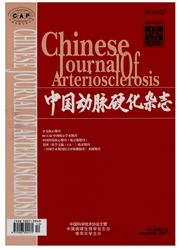

 中文摘要:
中文摘要:
目的探讨慢性宫内缺氧对子代大鼠心脏诱导型一氧化氮合酶、血清内皮素1的影响。方法建立慢性宫内缺氧大鼠模型,实验分为缺氧组、空气模拟对照组、空白对照组,每组10只子鼠。监测出生1天龄子鼠体重、各脏器重量,免疫组织化学法检测心肌细胞诱导型一氧化氮合酶的表达,酶联免疫吸附法检测1天龄、6月龄子鼠血清内皮素1的表达。结果宫内缺氧引起仔鼠主要脏器不成比例生长。宫内缺氧组子代大鼠出生时心肌诱导型一氧化氮合酶表达显著高于空气模拟对照组及空白对照组(P〈0.01),而空气模拟对照组与空白对照组比较差别无统计学意义。1天龄子鼠各组间血清内皮素1的表达差异无统计学意义,6月龄子鼠缺氧组显著高于空气模拟对照组及空白对照组(P〈0.01),而空气模拟对照组与空白对照组比较差别无统计学意义。结论慢性宫内缺氧作为孕期不良生长环境应激因素,可引起子鼠低出生体重以及主要脏器不成比例生长,并导致心脏诱导型一氧化氮合酶、血清内皮素1表达增高,致使心血管病风险性增高。
 英文摘要:
英文摘要:
Aim To study the effects of chronic intrauterine hypoxic on myocardial inducible nitric oxide synthase(iNOS) and plasma endothelin-1(ET-1). Methods Chronic intrauterine hypoxic rats were divided into three groups:hypoxic group,air mimic control group and blank control group.Each group included 10 offspring rats.We monitored the weight of organs and birth weight of offspring,immunohistochemistry was used to examine the expression of myocardial iNOS,enzyme linked immunosorbent assay(ELISA) was used to measure serum ET-1 expression of offspring at 1 day and 6 month old. Results Organ/body weight percentage showed chronic intrauterine hypoxia could cause a disproportionate growth of offspring organs.The expression of myocardial iNOS of the hypoxic group significantly increased compared with that of the air mimic control group and that of the blank control group(P0.05),but the air mimic control group was not significantly different from that of the blank control group(P0.05).There was no significant difference of the expression of the serum ET-1 of all groups of offspring at 1 day old(P0.05).But there was significant difference of the expression of the serum ET-1 of the hypoxic group compared with that of the air mimic control group and that of the blank control group of offspring at 6 month old(P0.05),while and the air mimic control group was not significantly different from that of the blank control group(P0.05). Conclusions Intrauterine chromic hypoxia may be a stress factor for development of the cardiovascular system,and it can induce low birth weight and high expression of myocardial iNOS and serum ET-1,which lead to increase the risk of cardiovascular disease.
 同期刊论文项目
同期刊论文项目
 同项目期刊论文
同项目期刊论文
 期刊信息
期刊信息
